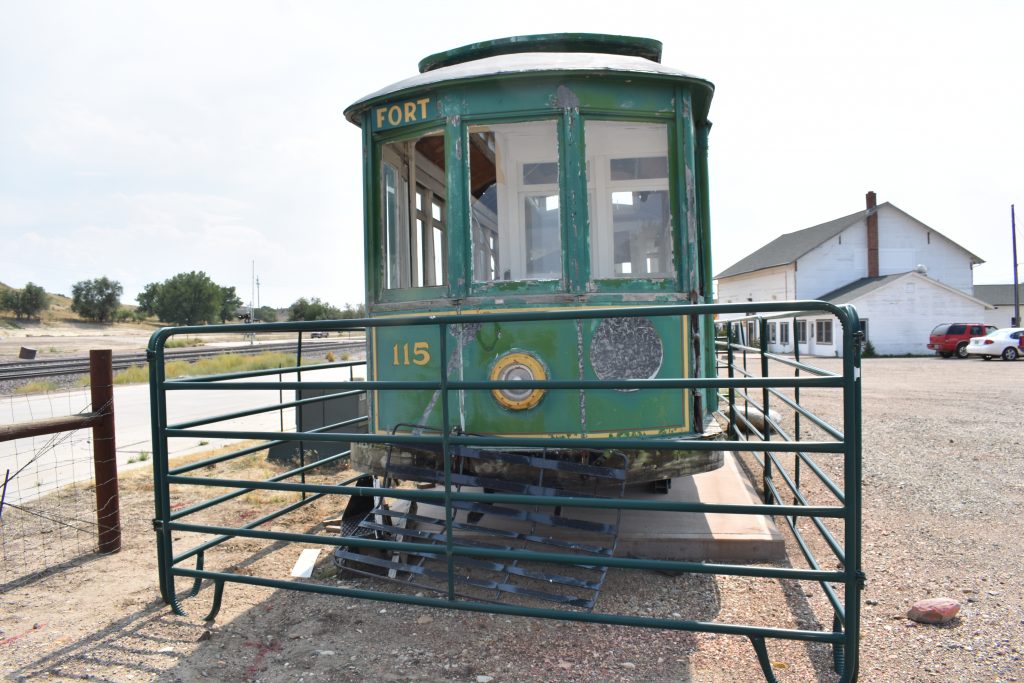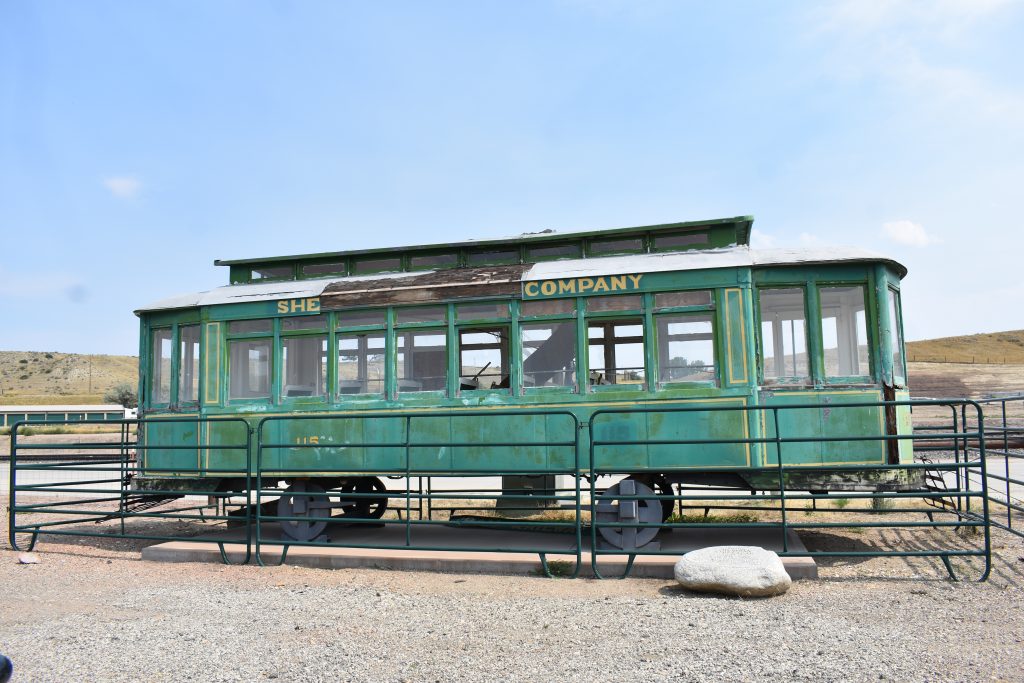alt
Sheridan’s Electric Street Cars
Sheridan’ Trolley Car, note the horses sharing the road. Photo courtesy of Wyoming State Archives, Elsa Spear Byron Photo.
In August of 1911, Sheridan residents were treated to a whole new mode of transportation, the electric trolley car.
In 1900, eleven years earlier, there were only 4,192 passenger cars built in the US, the only country manufacturing cars. Most of the farmers, ranchers and Sheridan residents still traveled in buggies or on horseback.
Due to autos being a new and scarce commodity – as well as the cost, around $850 – in 1910, there were few automobiles in Sheridan. However, more and more people began jumping on the automobile bandwagon.
In a March 13, 1908 Semi Weekly Enterprise article, adds for wagons and auto repairs appeared virtually side by side.
If you are in the market for a Wagon, Buggy, Carriage or Runabout, a trip through our warehouse will convince you that our line of vehicles is up-to-date, and that our goods are good and prices right. D. & D. Co.
Scotts Repair Shop, 90 East Brundage St. Sheridan, Shafting, injections, lubricators. Bicycles and sundries, Automobile work a specialty.

With horse and buggy still the major way to travel for most people, there was a need for faster and more modern transportation in Sheridan. Albert Emanuel and William Sullivan of the Electric Street Railway of Dayton, Ohio, proposed an electric streetcar system for Sheridan in 1910.
The line would run through Sheridan as well as serving as a direct line to the nearby coal camps. The City of Sheridan quickly approved the proposal and by July of 1910, rails were being laid. In just over one year’s time, the City Line was completed with service beginning on August 11, 1911.
Two articles in the Sheridan Daily Enterprise describe the excitement.
August 8,1911– Street cars in Sheridan today will arrive on no. 46 about 630 o’clock this afternoon. go over route tomorrow
First Street Car Ever Run in Northern Wyoming Will Leave Car Barn at 8:30 A. M. The Sheridan street cars will arrive st 5:30 o’clock this afternoon on the west bound freight train No. 45. They will be unloaded at the depot immediately or as soon as the planking leading to the ground can be arranged. The cars will be placed on the tracks at the Sheridan Inn and taken to the street car barn with their own power.
And on August 12, 1911
The Business Men celebrating today in appreciation of advent of street cars, jollification meeting is held. Ride over the route accompanied by a Band, the Three New Street Cars Leave Alger and Main Street.
The Sheridan Business Men’s club with a membership of over one hundred, has demonstrated itself to be a lively organization, working for the welfare of the city and county of Sheridan.
They perceived the commercial importance of a street car system for Sheridan and this afternoon they are celebrating the event with a ” jollification meeting.”
The three Sheridan street cars were chartered for this occasion and at the hour of going off to press they were assembling at the corner of Alger avenue and North Main street to take a ride over the route within the city’s limits.
A band of sixteen pieces boarded the first car and was followed by members of the club, and their invited guests, all “wearing souvenir badges proclaiming the opening of the Sheridan street railway system.”
Following the tremendous success of the City Line, a second route, the Fort Line, was established. The Fort Line went from Main Street, up Lewis Hill to the fairgrounds, across to Fort McKenzie, with a trestle across Deadman’s Draw. There was a turntable at the Fort, and passengers would help turn the streetcar around on it to ride back to town.
Once the city line was finished, the rails began pushing north to the coal camps.
The Daily Enterprise October 20, 1911
Interurban street car line pushing northward cars running to Dietz Nov. 1— Then On to Monarch – Construction Camps Are Seething With Men One of the most potent factors in elevating Sheridan to a city of metropolitan appearances is the street rail way system, owned by local and outside capitalists.
The local street car company as an indication of its faith in the future prospects of Sheridan and the Sheridan county, is now actively engaged in establishing an Interurban line to Dietz, New Acme, Carneyville and to Monarch.
The steel rails on this line are actually laid within one mile of Dietz, or two-thirds of the way across the Wrench ranch, estimated at five miles. Within another two or three weeks this interurban line will be constructed as far as Dietz and will be opened to traffic by the public.
Goose creek will be bridged three different times on the interurban line, all in the vicinity of Dietz.
The Tongue river will not be crossed by the interurban line on the entire route to the Monarch destination. Two large interurban cars from the St. Louis Car company, which manufactured the cars now in service, will be received in Sheridan next week, and will be ready for the initial run to Dietz when that line is opened. They are of a little different design than the Sheridan or Fort Mackenzie cars, and have double the capacity.
Several hundred men and teams are employed in constructing this grade.
Note that horse teams are still being used to construct the modern rail bed.
For those who may wonder how the electric street cars operated, the Sheridan Enterprise, Sept 29, 1914, had this detailed description: The Trolley Car. How the electric current moves it along the rails. its motors and mechanism. An Explanation of Their Working and the Method by Which the Mysterious Force is Conducted From the Overhead Wire to the Running Gear. …..In a vague way the vast majority of people who ride… (the street cars) know that it is driven by electric power which is arrived in some mysterious manner on the trolley wires.
Let us take the car apart, figuratively speaking, and see just how it is made. Underneath the ordinary street car you will find two to four powerful electric motors geared directly to the axles of the car. These motors are very powerful and are almost completely hidden from sight beneath the car. The electrical energy for driving the street cars is sent out over the trolley wires. The electrical power is generated in the central power house,… The trolley wire is suspended above the street from poles and guy wires. The electricity is kept on the trolley wires by suitable insulators of glass, porcelain or composition, over which the current cannot travel. The electrical current flows easily and smoothly along the trolley wire, like water in a pipe, although it cannot be seen.
Each trolley car is provided with a trolley wheel at the end of the pole which runs along the under side of the trolley wire. The electrical power from the trolley wire flows through this wheel and down the trolley pole to a heavily insulated cable concealed on the top of the car. This cable carries the electricity to the “controller” in front of the car. The controller is the iron box which stands in front of the in the motorman….When the motorman turns the controller handle a few notches a certain amount of electricity is allowed to flow from the overhead trolley wire down the pole, through the cable and control box to the motors beneath the car.
The current starts the motors, which in turn causes the wheels of the car to revolve, the car starts and the motorman turns the controller handle further, feeding the motors more current, and the car picks up to its regular running speed. The electrical current flows to the car over the trolley wire. After it flows through the car, via the cables, through the controller, the resistance and the motors, it flows out of the car through the iron wheels and back to the power house along the steel rails, thus completing the circuit.— Electrical News. A Whistler Story
At one time, the rail system had some 18 miles of track which including a spur line to the Holly Sugar Factory on Coffeen. Over the years, the system operated with no additional changes, and operations were fairly routine.
In a Jan, 1913 Sheridan Enterprise, the fares on the Sheridan Railway were publishes as follows: Single fares. Monarch 50 cents; Carneyville 30 cents; New Acme 25 cents; Dietz 15 cents. Tuesday and Wednesday the street car company placed excursion rates into effect from the coal camps to Sheridan and carried big crowds of people, The rates which prevailed on these two days were 55 cents from Monarch. 50 cents from Carneyville, 45 cents from Acme and 25 cents from Dietz, round trip rate.
The line operated for many years in Sheridan, but in 1923, as autos gained popularity in the area – in 1923 there were 3.7 million cars produced in the United States – The City of Sheridan decided to repave downtown Main Street, and discontinued the city trolley system. The Fort Line, however, continued operations until March of 1924, when it was replaced by a bus. The coal mine line lasted longer, into 1926, when it was also abandoned.

Some fifty years after the streetcars made their last runs, the dilapidated body of car #115 was discovered in a field outside of Sheridan. As part of the Bicentennial Celebration in 1976, #115 from the Fort Line was saved and moved into Sheridan. Today, #115 is the only remaining streetcar in the state of Wyoming. It sits near the old sale barn on Higby Road, a reminder of Sheridan’s growth from a frontier town to a bustling, modern city.

